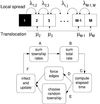Predicting the spatial dynamics of rabies epidemics on heterogeneous landscapes
- PMID: 11904426
- PMCID: PMC122581
- DOI: 10.1073/pnas.042400799
Predicting the spatial dynamics of rabies epidemics on heterogeneous landscapes
Abstract
Often as an epidemic spreads, the leading front is irregular, reflecting spatial variation in local transmission rates. We developed a methodology for quantifying spatial variation in rates of disease spread across heterogeneous landscapes. Based on data for epidemic raccoon rabies in Connecticut, we developed a stochastic spatial model of rabies spread through the state's 169 townships. We quantified spatial variation in transmission rates associated with human demography and key habitat features. We found that large rivers act as semipermeable barriers, leading to a 7-fold reduction in the local rates of propagation. By combining the spatial distribution of major rivers with long-distance dispersal we were able to account for the observed irregular pattern of disease spread across the state without recourse to direct assessment of host-pathogen populations.
Figures



Comment in
-
Rivers dam waves of rabies.Proc Natl Acad Sci U S A. 2002 Mar 19;99(6):3365-7. doi: 10.1073/pnas.062049599. Proc Natl Acad Sci U S A. 2002. PMID: 11904399 Free PMC article. No abstract available.
References
-
- Mollison D. Philos Trans R Soc London B. 1986;314:675–693.
-
- Plowright W. Rev Sci Tech. 1988;7:783–795. - PubMed
-
- Murray J D, Stanley E A, Brown D L. Proc R Soc London B. 1986;229:111–150. - PubMed
-
- Mollison D. Math Biosci. 1991;107:255–287. - PubMed
-
- Shigaseda N. In: Population Biology, Morphogenesis and Neurosciences: Lecture Notes in Biomathematics. Teramoto E, Yamaguti M, editors. Vol. 71. Heidelberg: Springer; 1987. pp. 88–97.
Publication types
MeSH terms
Grants and funding
LinkOut - more resources
Full Text Sources
Medical

